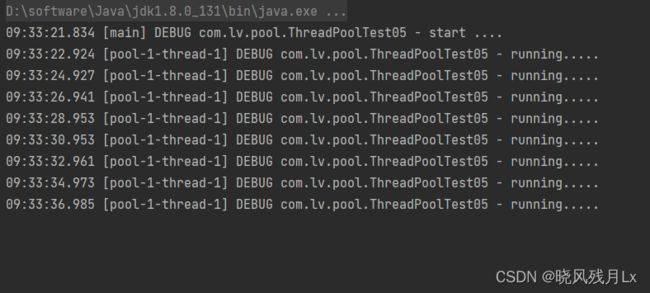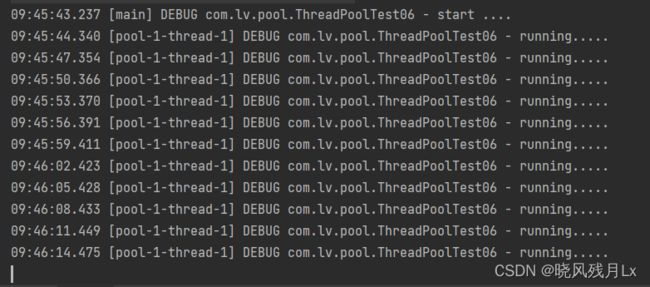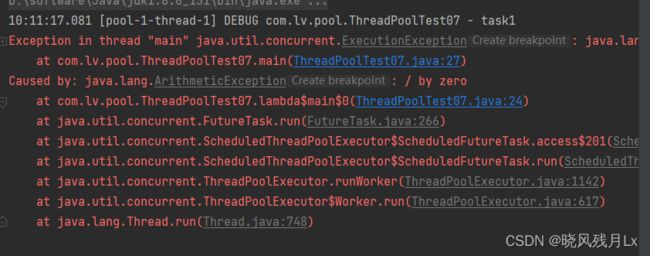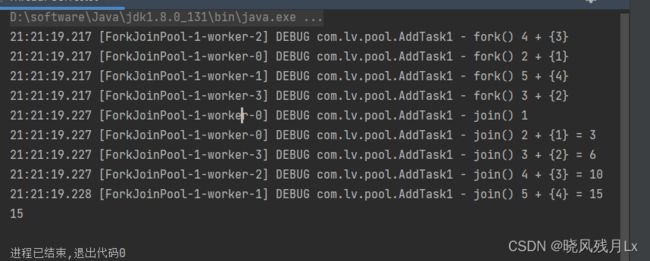JUC并发编程之线程池
1.自定义线程池
步骤1 自定义拒绝策略接口(实现函数式接口)
// 自定义拒绝策略
@FunctionalInterface
interface RejectPolicy<T> {
void reject(BlockingQueue<T> queue, T task);
}
步骤2 自定义任务队列
// 自定义任务队列
@Slf4j
class BlockingQueue<T> {
// 1.任务队列 双端队列
private Deque<T> queue = new ArrayDeque<>();
// 2.锁
private ReentrantLock reentrantLock = new ReentrantLock();
// 3.生产者条件变量
private Condition fullwaitSet = reentrantLock.newCondition();
// 4.消费者条件变量
private Condition emptywaitSet = reentrantLock.newCondition();
// 5.容器
private int capcity;
public BlockingQueue(int capcity) {
this.capcity = capcity;
}
// 带超时阻塞获取
public T poll(long timeout, TimeUnit unit) {
try {
reentrantLock.lock();
long nanos = unit.toNanos(timeout);
while (queue.isEmpty()) {
try {
// 返回值是剩余时间
if (nanos <= 0) {
return null;
}
nanos = emptywaitSet.awaitNanos(nanos);
} catch (InterruptedException e) {
e.printStackTrace();
}
}
T t = queue.removeFirst();
fullwaitSet.signal();
return t;
} finally {
reentrantLock.unlock();
}
}
// 阻塞获取
public T take() {
reentrantLock.lock();
try {
while (queue.isEmpty()) {
try {
emptywaitSet.await();
} catch (InterruptedException e) {
e.printStackTrace();
}
}
T t = queue.removeFirst();
fullwaitSet.signal();
return t;
} finally {
reentrantLock.unlock();
}
}
// 阻塞添加
public void put(T task) {
reentrantLock.lock();
try {
while (queue.size() == capcity) {
try {
log.debug("等待加入任务队列 {} ...", task);
fullwaitSet.await();
} catch (InterruptedException e) {
e.printStackTrace();
}
}
log.debug("加入任务队列 {}", task);
queue.addLast(task);
emptywaitSet.signal();
} finally {
reentrantLock.unlock();
}
}
// 带超时时间的阻塞添加
public boolean offer(T task, long timeout, TimeUnit timeUnit) {
reentrantLock.lock();
try {
long nanos = timeUnit.toNanos(timeout);
while (queue.size() == capcity) {
try {
if (nanos <= 0) {
return false;
}
log.debug("等待加入任务队列 {} ....", task);
nanos = fullwaitSet.awaitNanos(nanos);
} catch (InterruptedException e) {
e.printStackTrace();
}
}
log.debug("加入任务队列 {}", task);
queue.addLast(task);
emptywaitSet.signal();
return true;
} finally {
reentrantLock.unlock();
}
}
public int size() {
reentrantLock.lock();
try {
return queue.size();
} finally {
reentrantLock.unlock();
}
}
public void tryPut(RejectPolicy<T> rejectPolicy, T task) {
reentrantLock.lock();
try {
// 判断队列是否满
if (queue.size() == capcity) {
rejectPolicy.reject(this, task);
} else {
// 有空闲
log.debug("加入任务队列 {}", task);
queue.addLast(task);
emptywaitSet.signal();
}
} finally {
reentrantLock.unlock();
}
}
}
步骤3 自定义线程池
@Slf4j
class ThreadPool {
// 任务队列
private BlockingQueue<Runnable> taskQueue;
// 线程集合
private HashSet<Worker> workers = new HashSet<>();
// 核心线程数
private int coreSize;
// 获取任务时的超时时间
private long timeout;
private TimeUnit timeUnit;
private RejectPolicy<Runnable> rejectPolicy;
// 执行任务
public void execute(Runnable task) {
// 当任务数没有超过 coreSize , 交给worker 对象执行
// 如果任务数超过 coreSize , 交给任务队列暂存
synchronized (workers) {
if (workers.size() < coreSize) {
Worker worker = new Worker(task);
log.debug("新增 worker{} , {}", worker, task);
workers.add(worker);
worker.start();
} else {
// taskQueue.put(task);
// 1) 死等
// 2) 带超时等待
// 3) 让调用者放弃任务执行
// 4) 让调用者抛出异常
// 5) 让调用者自己执行任务
taskQueue.tryPut(rejectPolicy, task);
}
}
}
public ThreadPool(int coreSize, long timeout, TimeUnit timeUnit, int queueCapcity, RejectPolicy<Runnable> rejectPolicy) {
this.coreSize = coreSize;
this.timeout = timeout;
this.timeUnit = timeUnit;
this.taskQueue = new BlockingQueue<>(queueCapcity);
this.rejectPolicy = rejectPolicy;
}
class Worker extends Thread {
private Runnable task;
public Worker(Runnable task) {
this.task = task;
}
public void run() {
// 执行任务
// 1.当task不为空,执行
// 2.当task为空,再接着从任务队列获取任务并执行
while (task != null || (task = taskQueue.poll(timeout, timeUnit)) != null) {
try {
log.debug("正在执行 {} ....", task);
task.run();
} catch (Exception e) {
e.printStackTrace();
} finally {
task = null;
}
}
synchronized (workers) {
log.debug("workers 被移除 {}", this);
workers.remove(this);
}
}
}
}
步骤四 测试
public static void main(String[] args) {
ThreadPool threadPool = new ThreadPool(1, 1000, TimeUnit.MILLISECONDS, 1, ((queue, task) -> {
// 1. 死等
// queue.put(task);
// 2) 带超时等待
// queue.offer(task, 1500, TimeUnit.MILLISECONDS);
// 3) 让调用者放弃任务执行
// log.debug("放弃{}", task);
// 4) 让调用者抛出异常
// throw new RuntimeException("任务执行失败 " + task);
// 5) 让调用者自己执行任务
task.run();
}));
for (int i = 0; i < 4; i++) {
int j = i;
threadPool.execute(() -> {
try {
Thread.sleep(1000L);
} catch (InterruptedException e) {
e.printStackTrace();
}
log.debug("{}", j);
});
}
}
2.ThreadPoolExecutor
1.线程池状态
ThreadPoolExecutor 使用 int 的高 3 位来表示线程池状态,低 29 位表示线程数量
从数字上比较,TERMINATEND > TIDYING > STOP > SHUTDOWN > RUNNING
这些信息存储在一个原子变量 ctl 中,目的是将线程池状态与线程个数合二为一,这样就可以用一次 cas 原子操作进行赋值
// c位旧值, ctlof 返回结果为新值
ctl.compareAndSet(c, ctlOf(targetState, workerCountOf(c))))
// rs 为高 3 位代表线程池状态, wc 为低 29 位 代表线程个数, ctl 是合并它们
private static int ctlOf(int rs, int wc) { return rs | wc; }
2.构造方法
public ThreadPoolExecutor(int corePoolSize,
int maximumPoolSize,
long keepAliveTime,
TimeUnit unit,
BlockingQueue<Runnable> workQueue,
RejectedExecutionHandler handler) {
this(corePoolSize, maximumPoolSize, keepAliveTime, unit, workQueue,
Executors.defaultThreadFactory(), handler);
}
- corePoolSize 核心线程数目 (最多保留的线程数)
- maximumPoolSize 最大线程数目
- keepAliveTime 生存时间 - 针对救急线程
- unit 时间单位 - 针对救急线程
- workQueue 阻塞队列
- threadFactory 线程工厂 - 可以为线程创建时起个好名字 handler 拒绝策略
工作方式
-
线程池中刚开始没有线程,当一个任务提交给线程池后,线程池会创建一个新线程来执行任务
-
当线程数达到 corePoolSize 并没有线程空闲,这时再加入任务,新加的任务会被加入 workQueue 队列排队,直到有空闲的线程
-
如果队列选择了有界队列,那么任务超过了队列大小时,会创建 maximumPoolSize - corePoolSize 数目的线程来救急
-
如果线程到达 maximumPoolSize 仍然有新任务会执行拒绝策略。拒绝策略 jdk 提供了 4 种实现,其它著名框架也提供了实现
- AbortPolicy 让调用者抛出 RejectedExecutionException 异常,这是默认策略
- CallerRunsPolicy 让调用者运行任务
- DiscardPolicy 放弃本次任务
- DiscardOldestPolicy 放弃队列中最早的任务,本任务取而代之
- Dubbo 的实现,在抛出 RejectedExecutionException 异常之前会记录日志,并 dump 线程栈信息,方 便定位问题
- Netty 的实现,是创建一个新线程来执行任务
- ActiveMQ 的实现,带超时等待(60s)尝试放入队列,类似我们之前自定义的拒绝策略
- PinPoint 的实现,它使用了一个拒绝策略链,会逐一尝试策略链中每种拒绝策略
-
当高峰过去,超过corePoolSize的救急线程如果一段时间任务可做,需要结束节省资源,这个时间由 keepAliveTime 和 unit 来控制
根据这个构造方法,JDK Executors 类种提供了众多工厂方法来创建各种用途的线程池
3. newFixedThreadPool
JDK Executors类中
public static ExecutorService newFixedThreadPool(int nThreads) {
return new ThreadPoolExecutor(nThreads, nThreads,
0L, TimeUnit.MILLISECONDS,
new LinkedBlockingQueue<Runnable>());
}
特点
- 核心线程 == 最大线程数(没有救急线程被创建),因此也无需超时时间
- 阻塞队列是无界的,可以放任意数量的任务
创建一个由固定数量线程并在共享无界队列上运行的线程池,在任何时候都最多只有nThreads个线程存在并执行任务。
如果在任务提交时,所有线程都在工作中,则会将该任务放入到队列中等待,直到有可用的线程。如果某个线程在执行过程中出现异常,那么这个线程会终止,并且会有一个新的线程代替它进行后续的工作,线程池中的线程会一直存在直到线程池被明确的停止掉。
- 适用于任务量已知,相对耗时的任务
4. newCachedThreadPool
public static ExecutorService newCachedThreadPool() {
return new ThreadPoolExecutor(0, Integer.MAX_VALUE,
60L, TimeUnit.SECONDS,
new SynchronousQueue<Runnable>());
}
特点:
- 核心线程数是0,最大线程数是Integer.MAX_VALUE,救急线程的空闲生存时间是60s,意味着
- 全部都是救急线程(60s后可以回收)
- 救急线程可以无限创建
- 队列采用了 SynchronousQueue 实现特点是,他没有容量,没有线程来取是放不进去的
通过该方法会创建一个线程池,当你执行一个任务,并且线程池中不存在可用的已构造好的线程时,它就会创建一个新线程,否则它会优先复用已有的线程,当线程未被使用时,默认 6 秒后被移除。这些线程池可以很明显的提升那些短期存活的异步任务的执行效率
import lombok.extern.slf4j.Slf4j;
import java.util.concurrent.SynchronousQueue;
import static com.lv.juc.util.Sleeper.sleep;
/**
* @author 晓风残月Lx
* @date 2023/3/28 12:58
*/
@Slf4j
public class ThreadPoolTest2 {
public static void main(String[] args) {
SynchronousQueue<Integer> integers = new SynchronousQueue<>();
new Thread(() -> {
try {
log.debug("putting {} ", 1);
integers.put(1);
log.debug("{} putted...", 1);
log.debug("putting...{} ", 2);
integers.put(2);
log.debug("{} putted...", 2);
} catch (InterruptedException e) {
e.printStackTrace();
}
},"t1").start();
sleep(1);
new Thread(() -> {
try {
log.debug("taking {}", 1);
integers.take();
} catch (InterruptedException e) {
e.printStackTrace();
}
},"t2").start();
sleep(1);
new Thread(() -> {
try {
log.debug("taking {}", 2);
integers.take();
} catch (InterruptedException e) {
e.printStackTrace();
}
},"t3").start();
}
}
- 整个线程池表现为线程数会根据任务量不断增长,没有上限,当任务执行完毕,空闲 1分钟后释放线 程。 适合任务数比较密集,但每个任务执行时间较短的情况
5. newSingleThreadExecutor
public static ExecutorService newSingleThreadExecutor() {
return new FinalizableDelegatedExecutorService
(new ThreadPoolExecutor(1, 1,
0L, TimeUnit.MILLISECONDS,
new LinkedBlockingQueue<Runnable>()));
}
使用场景:
希望多个任务排队执行,线程数固定为1,任务数多于1时,会放入无界队列排队。任务执行完毕,这唯一的线程也不会被释放
区别
- 自己创建一个单线程串行执行任务,如果任务执行失败而终止那么没有任何补救措施,线程池会新建一个线程,保证线程池的正常工作
- Executors.newSingleThreadExecutor() 线程个数始终为 1,不能修改
- FinalizableDelegatedExecutorService 应用的是装饰器模式,只对外暴露了ExecutorService 接口,因此不能调用 ThreadPoolExecutor 中特有的方法
- Executors.newFixedThreadPool(1) 初始时为1,以后还可以修改
- 对外暴露的是 ThreadPoolExecutor 对象,可以强转后调用 setCorePoolSize 等方法进行修改
6.提交任务
// 执行任务
public void execute(Runnable command) {
e.execute(command);
}
// 提交任务 task,用返回值 Future 或得任务执行结果
public <T> Future<T> submit(Callable<T> task) {
return e.submit(task);
}
// 提交 tasks 中所有任务,带超时时间·
public <T> List<Future<T>> invokeAll(Collection<? extends Callable<T>> tasks) throws InterruptedException {
return e.invokeAll(tasks);
}
// 提交 tasks 中所有任务
public <T> List<Future<T>> invokeAll(Collection<? extends Callable<T>> tasks) throws InterruptedException {
return e.invokeAll(tasks);
}
// 提交 tasks 中所有任务,哪个任务先成功执行完毕,返回此任务执行结果,其它任务取消
public <T> T invokeAny(Collection<? extends Callable<T>> tasks) throws InterruptedException, ExecutionException {
return e.invokeAny(tasks);
}
// 提交 tasks 中所有任务,哪个任务先成功执行完毕,返回此任务执行结果,其它任务取消,带超时时间
public <T> T invokeAny(Collection<? extends Callable<T>> tasks, long timeout, TimeUnit unit)
throws InterruptedException, ExecutionException, TimeoutException {
return e.invokeAny(tasks, timeout, unit);
}
7.关闭线程
shutdown
/*
Executors
线程池状态变为 SHUTDOWN
- 不会接收新任务
- 但已提交任务会执行完
- 此方法不会阻塞调用线程的执行
*/
public void shutdown() { e.shutdown(); }
// ThreadPoolExecutor
public List<Runnable> shutdownNow() {
List<Runnable> tasks;
final ReentrantLock mainLock = this.mainLock;
mainLock.lock();
try {
checkShutdownAccess();
advanceRunState(STOP);
interruptWorkers();
tasks = drainQueue();
} finally {
mainLock.unlock();
}
tryTerminate();
return tasks;
}
其他方法
从数字上比较,TERMINATEND > TIDYING > STOP > SHUTDOWN > RUNNING
// Executors类
// 不在Running状态的线程池,此方法就返回true
public boolean isShutdown() { return e.isShutdown(); }
// 线程池状态是否是 TERMINATED
public boolean isTerminated() { return e.isTerminated(); }
/*
调用 shutdown 后,由于调用线程并不会等待所有任务运行结束,
因此如果它想在线程池 TERMINATED 后做些事情,可以利用此方法等待
*/
public boolean awaitTermination(long timeout, TimeUnit unit)
throws InterruptedException {
return e.awaitTermination(timeout, unit);
}
// ThreadPoolExecutor
// 不在Running状态的线程池,此方法就返回true
public boolean isShutdown() {
return ! isRunning(ctl.get());
}
private static boolean isRunning(int c) {
return c < SHUTDOWN;
}
// 线程池状态是否是 TERMINATED
public boolean isTerminated() {
return runStateAtLeast(ctl.get(), TERMINATED);
}
private static boolean runStateAtLeast(int c, int s) {
return c >= s;
}
/*
调用 shutdown 后,由于调用线程并不会等待所有任务运行结束,
因此如果它想在线程池 TERMINATED 后做些事情,可以利用此方法等待
*/
public boolean awaitTermination(long timeout, TimeUnit unit)
throws InterruptedException {
long nanos = unit.toNanos(timeout);
final ReentrantLock mainLock = this.mainLock;
mainLock.lock();
try {
for (;;) {
if (runStateAtLeast(ctl.get(), TERMINATED))
return true;
if (nanos <= 0)
return false;
nanos = termination.awaitNanos(nanos);
}
} finally {
mainLock.unlock();
}
}
8. 任务调度线程池
在任务调度线程池功能加入之前,可以使用 java.util.Timer 来实现定时功能,Timer 的优点在于简单易用,但由于所有任务都是由一个线程来调度,因此所有任务都是串行执行的,同一时间只能有一个任务在执行,前一个人物的延迟或异常都将会影响到之后的任务
/**
* @author 晓风残月Lx
* @date 2023/4/4 9:15
*/
@Slf4j
public class ThreadPoolTest03 {
public static void main(String[] args) {
Timer timer = new Timer();
TimerTask task1 = new TimerTask() {
@Override
public void run() {
log.debug("task 1");
Sleeper.sleep(2);
}
};
TimerTask task2 = new TimerTask() {
@Override
public void run() {
log.debug("task 2");
}
};
// 使用 timer 添加两个任务,希望它们都在 1s 后执行
// 但由于 timer 内只有一个线程来顺序执行队列中的任务,因此『任务1』的延时,影响了『任务2』的执行
timer.schedule(task1, 1000);
timer.schedule(task2, 1000);
}
}
改成 ScheduleExecutorService(并行执行)
import com.lv.juc.util.Sleeper;
import lombok.extern.slf4j.Slf4j;
import java.util.Date;
import java.util.concurrent.Executors;
import java.util.concurrent.ScheduledExecutorService;
import java.util.concurrent.TimeUnit;
/**
* @author 晓风残月Lx
* @date 2023/4/4 9:18
*/
@Slf4j
public class ThreadPoolTest04 {
public static void main(String[] args) {
ScheduledExecutorService executorService = Executors.newScheduledThreadPool(2);
// 添加两个任务,希望在1s后执行
executorService.schedule(() -> {
System.out.println("任务1 执行时间:" + new Date());
Sleeper.sleep(2);
}, 1000, TimeUnit.MICROSECONDS);
executorService.schedule(() -> {
System.out.println("任务2 执行时间:" + new Date());
}, 1000, TimeUnit.MICROSECONDS);
}
}
使用 scheduleAtFixedRate
import lombok.extern.slf4j.Slf4j;
import java.util.Date;
import java.util.concurrent.Executors;
import java.util.concurrent.ScheduledExecutorService;
import java.util.concurrent.TimeUnit;
/**
* @author 晓风残月Lx
* @date 2023/4/4 9:18
*/
@Slf4j
public class ThreadPoolTest05 {
public static void main(String[] args) {
ScheduledExecutorService pool = Executors.newScheduledThreadPool(1);
log.debug("start ....");
pool.scheduleAtFixedRate(() -> {
log.debug("running.....");
},1,1, TimeUnit.SECONDS);
}
}
scheduleAtFixedRate (任务执行时间超过了间隔时间):
import com.lv.juc.util.Sleeper;
import lombok.extern.slf4j.Slf4j;
import java.util.concurrent.Executors;
import java.util.concurrent.ScheduledExecutorService;
import java.util.concurrent.TimeUnit;
/**
* @author 晓风残月Lx
* @date 2023/4/4 9:18
*/
@Slf4j
public class ThreadPoolTest05 {
public static void main(String[] args) {
ScheduledExecutorService pool = Executors.newScheduledThreadPool(1);
log.debug("start ....");
pool.scheduleAtFixedRate(() -> {
log.debug("running.....");
Sleeper.sleep(2);
},1,1, TimeUnit.SECONDS);
}
}
输出分析:一开始,延时 1s,接下来,由于任务执行时间 > 间隔时间,间隔到了 2s
scheduleWithFixedDelay
import com.lv.juc.util.Sleeper;
import lombok.extern.slf4j.Slf4j;
import java.util.concurrent.Executors;
import java.util.concurrent.ScheduledExecutorService;
import java.util.concurrent.TimeUnit;
/**
* @author 晓风残月Lx
* @date 2023/4/4 9:18
*/
@Slf4j
public class ThreadPoolTest06 {
public static void main(String[] args) {
ScheduledExecutorService pool = Executors.newScheduledThreadPool(1);
log.debug("start ....");
pool.scheduleWithFixedDelay(() -> {
log.debug("running.....");
Sleeper.sleep(2);
},1,1, TimeUnit.SECONDS);
}
}
输出分析:scheduleWithFixedDelay的间隔时间是上一个执行完毕,才会调用下一个任务开始
scheduleWithFixedDelay 和 scheduleAtFixedRate 的区别
- scheduleWithFixedDelay 是上一个任务结束,才会调用下一个任务
- scheduleAtFixedRate
- 任务执行时间 > 设置的延迟时间,任务执行时间为间隔时间,
- 任务执行时间 < 设置的延迟时间,设置的延迟时间为间隔时间
9.处理执行异常
方法1:主动捉异常
import java.util.concurrent.Executors;
import java.util.concurrent.ScheduledExecutorService;
/**
* @author 晓风残月Lx
* @date 2023/4/4 9:18
*/
@Slf4j
public class ThreadPoolTest07 {
public static void main(String[] args) {
ScheduledExecutorService pool = Executors.newScheduledThreadPool(1);
log.debug("start ....");
pool.submit(() -> {
try {
log.debug("task1");
int i = 1 / 0;
} catch (Exception e) {
log.error("error :",e);
}
});
}
}
方法2:使用Future
import lombok.extern.slf4j.Slf4j;
import java.util.concurrent.ExecutionException;
import java.util.concurrent.Executors;
import java.util.concurrent.Future;
import java.util.concurrent.ScheduledExecutorService;
/**
* @author 晓风残月Lx
* @date 2023/4/4 9:18
*/
@Slf4j
public class ThreadPoolTest07 {
public static void main(String[] args) throws ExecutionException, InterruptedException {
ScheduledExecutorService pool = Executors.newScheduledThreadPool(1);
Future<Boolean> future = pool.submit(() -> {
log.debug("task1");
int i = 1 / 0;
return true;
});
log.debug("result: {}", future.get());
}
}
Future 可以使用 get() 方法捕获异常
10. Tomcat 线程池
- LimitLatch 用来限流,可以控制最大连接个数
- Acceptor 只负责 【接收新的 socket 连接】
- Poller 只负责监听 socket channel 是否有 【可读的 I/O 事件】
- 一旦可读,封装成一个任务对象(socketProcessor),提交给Executor线程池处理
- Executor 线程池中的工作线程最终负责 【处理请求】
Tomcat 线程池扩展了 ThreadPoolExecutor , 稍有不同
- 如果总线程数达到 maximumPoolSize
- 这时不会立刻抛 RejectedExecutionException 异常
- 而是再次尝试将任务放入队列,如果还是失败,才会抛出RejectedExecutionException 异常
源码 tomcat-7.0.42
public void execute(Runnable command, long timeout, TimeUnit unit) {
submittedCount.incrementAndGet();
try {
super.execute(command);
} catch (RejectedExecutionException rx) {
if (super.getQueue() instanceof TaskQueue) {
final TaskQueue queue = (TaskQueue)super.getQueue();
try {
if (!queue.force(command, timeout, unit)) {
submittedCount.decrementAndGet();
throw new RejectedExecutionException("Queue capacity is full.");
}
} catch (InterruptedException x) {
submittedCount.decrementAndGet();
Thread.interrupted();
throw new RejectedExecutionException(x);
}
} else {
submittedCount.decrementAndGet();
throw rx;
}
}
}
TaskQueue.java
public boolean force(Runnable o, long timeout, TimeUnit unit) throws InterruptedException {
if ( parent.isShutdown() )
throw new RejectedExecutionException(
"Executor not running, can't force a command into the queue"
);
return super.offer(o,timeout,unit); //forces the item onto the queue, to be used if the task
is rejected
}
Connector 配置
| 配置项 | 默认值 | 说明 |
|---|---|---|
| acceptorThreadCount | 1 | acceptor 线程数量 |
| pollerThreadCount | 1 | poller 线程数量 |
| minSpareThreads | 10 | 核心线程数,即 corePoolSize |
| maxThreads | 200 | 最大线程数,即 maximumPoolSize |
| executor | - | Executor名称,用来引用下面的 Executor |
Executor 线程配置
| 配置项 | 默认值 | 说明 |
|---|---|---|
| threadPriority | 5 | 线程优先级 |
| daemon | true | 是否守护线程 |
| minSpareThreads | 25 | 核心线程数,即corePoolSize |
| maxThreads | 200 | 最大线程数,即maximumPoolSize |
| maxIdleTime | 60000 | 线程生存时间,单位是毫秒,默认值即 1 分钟 |
| maxQueueSize | Integer.MAX_VALUE | 队列长度 |
| prestartminSpareThreads | false | 核心线程是否在服务器启动时启动 |
3.Fork/Join
1 概念
Fork / Join 是 JDK 1.7 加入的新的线程池的实现,它体现的是一种分治思想,适用于能够进行任务拆分的 cpu 密集型运算
所谓的任务拆分,是将一个大任务拆分为算法上相同的小任务,直至不能拆分可以直接求解。跟递归相关的一些计 算,如归并排序、斐波那契数列、都可以用分治思想进行求解
Fork/Join 在分治的基础上加入了多线程,可以把每个任务的分解和合并交给不同的线程来完成,进一步提升了运算效率
Fork/Join 默认会创建与 cpu 核心数大小相同的线程池
2 使用
提交给 Fork / Join 线程池的任务需要继承 RecursiveTask(有返回值)或
RecursiveAction(没有返回值),下面定义了一个对 1~n 之间的整数求和的任务
import lombok.extern.slf4j.Slf4j;
import java.time.DayOfWeek;
import java.time.Duration;
import java.time.LocalDateTime;
import java.util.Date;
import java.util.concurrent.*;
/**
* @author 晓风残月Lx
* @date 2023/4/4 9:18
*/
@Slf4j
public class ThreadPoolTest09 {
public static void main(String[] args) {
ForkJoinPool pool = new ForkJoinPool(4);
System.out.println(pool.invoke(new AddTask1(5)));
}
}
@Slf4j
class AddTask1 extends RecursiveTask<Integer> {
int n;
public AddTask1(int n){
this.n = n;
}
public String toString() {
return "{" + n + "}";
}
@Override
protected Integer compute() {
// 如果 n 已经为 1 ,可以求得结果
if (n == 1) {
log.debug("join() {}", n);
return n;
}
// 将任务进行拆分(fork)
AddTask1 t1 = new AddTask1(n - 1);
t1.fork();
log.debug("fork() {} + {}", n, t1);
// 合并(join)结果
int result = n + t1.join();
log.debug("join() {} + {} = {}", n, t1, result);
return result;
}
}
改进
import lombok.extern.slf4j.Slf4j;
import java.util.concurrent.ForkJoinPool;
import java.util.concurrent.RecursiveTask;
/**
* @author 晓风残月Lx
* @date 2023/4/4 9:18
*/
@Slf4j
public class ThreadPoolTest10 {
public static void main(String[] args) {
ForkJoinPool pool = new ForkJoinPool(4);
System.out.println(pool.invoke(new AddTask3(1, 5)));
}
}
@Slf4j
class AddTask3 extends RecursiveTask<Integer> {
int begin;
int end;
public AddTask3(int begin, int end){
this.begin = begin;
this.end = end;
}
public String toString() {
return "{" + begin + ","+ end + "}";
}
@Override
protected Integer compute() {
// 5, 5
if (begin == end) {
log.debug("join() {}", begin);
return begin;
}
// 4, 5
if (end - begin == 1) {
log.debug("join() {} + {} = {}", begin, end, end + begin);
return end + begin;
}
// 1, 5
int mid = (end + begin) / 2; // 3
AddTask3 t1 = new AddTask3(begin, mid); // 1,3
t1.fork();
AddTask3 t2 = new AddTask3(mid + 1, end); // 4,5
t2.fork();
log.debug("fork() {} + {} = ?", t1, t2);
int result = t1.join() + t2.join();
log.debug("join() {} + {} = {}", t1, t2, result);
return result;
}
}
异步模式之工作线程
1.定义
让有限的工作线程(Worker Thread)来轮流异步处理无限多的任务。也可以将其归类为分工模式,他的典型实现就是线程池,也体现了经典设计模式中的享元模式
例如,海底捞的服务员(线程),轮流处理每位客人的点餐(任务),如果为每位客人都配一名专属的服务员,那 么成本就太高了(对比另一种多线程设计模式:Thread-Per-Message)
注意,不同任务类型应该使用不同的线程池,这样能够避免饥饿,并能提升效率
例如,如果一个餐馆的工人既要招呼客人(任务类型A),又要到后厨做菜(任务类型B)显然效率不咋地,分成 服务员(线程池A)与厨师(线程池B)更为合理,当然你能想到更细致的分工
2.饥饿
固定大小线程池会饥饿现象
- 两个公认是同一个线程池的两个线程
- 他们要做的事情是:为客人点餐和到后厨做菜,这时两个阶段的工作
- 客人点菜:必须先点完餐,等菜做好,上菜,在此期间处理点餐的工人必须等待
- 后厨做菜:没啥说的,做就完了
- 比如工人A 处理了点餐任务,接下来它要等着 工人B 把菜做好,然后上菜,他俩也配合的蛮好
- 但现在同时来了两个客人,这个时候工人A 和工人B 都去处理点餐了,这时没人做饭了,饥饿
@Slf4j
public class TestDeadLock {
static final List<String> MENU = Arrays.asList("红烧肉","孜然羊肉","烤鱼","红烧排骨");
static Random RANDOM = new Random();
static String cooking() {
return MENU.get(RANDOM.nextInt(MENU.size()));
}
public static void main(String[] args) {
ExecutorService waiterPool = Executors.newFixedThreadPool(1);
ExecutorService cookPool = Executors.newFixedThreadPool(1);
waiterPool.execute(() -> {
log.debug("处理点餐....");
Future<String> f = cookPool.submit(() -> {
log.debug("做菜");
return cooking();
});
try {
log.debug("上菜:{}", f.get());
} catch (Exception e) {
e.printStackTrace();
}
});
// waiterPool.execute(() -> {
// log.debug("处理点餐");
// Future f = cookPool.submit(() -> {
// log.debug("做菜");
// return cooking();
// });
// try {
// log.debug("上菜:{}", f.get());
// } catch (Exception e) {
// e.printStackTrace();
// }
// });
}
}
当注释取消后,可能会出现
17:08:41.339 c.TestDeadLock [pool-1-thread-2] - 处理点餐...
17:08:41.339 c.TestDeadLock [pool-1-thread-1] - 处理点餐...
解决方法可以增加线程池的大小,不过不是根本解决方案,还是前面提到的,不同的任务类型,采用不同的线程池
@Slf4j
public class TestDeadLock {
static final List<String> MENU = Arrays.asList("红烧肉","孜然羊肉","烤鱼","红烧排骨");
static Random RANDOM = new Random();
static String cooking() {
return MENU.get(RANDOM.nextInt(MENU.size()));
}
public static void main(String[] args) {
ExecutorService waiterPool = Executors.newFixedThreadPool(1);
ExecutorService cookPool = Executors.newFixedThreadPool(1);
waiterPool.execute(() -> {
log.debug("处理点餐....");
Future<String> f = cookPool.submit(() -> {
log.debug("做菜");
return cooking();
});
try {
log.debug("上菜:{}", f.get());
} catch (Exception e) {
e.printStackTrace();
}
});
waiterPool.execute(() -> {
log.debug("处理点餐");
Future<String> f = cookPool.submit(() -> {
log.debug("做菜");
return cooking();
});
try {
log.debug("上菜:{}", f.get());
} catch (Exception e) {
e.printStackTrace();
}
});
}
}
3.创建多少线程池合适
- 过小会导致程序不能充分地利用系统资源,容易导致饥饿
- 过大会导致更多的线程上下文切换,占用更多内存
3.1 CPU密集型运算
通常采用 cpu 核数 + 1 能够实现最优的 CPU 利用率, +1 是保证当线程由于页缺失故障(操作系统)导致暂停时,额外的这个线程就能顶上去,保证CPU时钟周期不被浪费
3.2 I/O 密集型运算
CPU 不总是处于繁忙状态,例如,当你执行业务计算时,这时候会使用 CPU 资源,但当你执行 I/O 操作时、远程 RPC 调用时,包括进行数据库操作时,这时候 CPU 就闲下来了,你可以利用多线程提高它的利用率。
经验公式如下
线程数 = 核数 * 期望 CPU 利用率 * 总时间(CPU计算时间+等待时间) / CPU 计算时间
例如 4 核 CPU 计算时间是 50% ,其它等待时间是 50%,期望 cpu 被 100% 利用,套用公式
4 * 100% * 100% / 50% = 8
例如 4 核 CPU 计算时间是 10% ,其它等待时间是 90%,期望 cpu 被 100% 利用,套用公式
4 * 100% * 100% / 10% = 40
4.自定义线程池
定时任务
如何定时执行
import lombok.extern.slf4j.Slf4j;
import java.time.DayOfWeek;
import java.time.Duration;
import java.time.LocalDateTime;
import java.util.Date;
import java.util.concurrent.*;
/**
* @author 晓风残月Lx
* @date 2023/4/4 9:18
*/
@Slf4j
public class ThreadPoolTest08 {
public static void main(String[] args) throws ExecutionException, InterruptedException {
LocalDateTime now = LocalDateTime.now();
// 获取周二 10 : 40: 00 .000
LocalDateTime tuesday = now.with(DayOfWeek.TUESDAY).withHour(10).withMinute(40).withSecond(0).withNano(0);
// 如果超过了这个点 就下周在执行
if (now.compareTo(tuesday) >= 0) {
tuesday = tuesday.plusWeeks(1);
}
// 计算时间差,即延时执行时间
long initialDelay = Duration.between(now, tuesday).toMillis();
// 计算间隔时间,即 1 周的毫秒值
long oneWeek = 7 * 24 * 3600 * 1000;
ScheduledExecutorService executor = Executors.newScheduledThreadPool(2);
System.out.println("开始时间:" + new Date());
executor.scheduleAtFixedRate(() -> {
System.out.println("执行时间:" + new Date());
}, initialDelay, oneWeek, TimeUnit.MILLISECONDS);
}
}





















